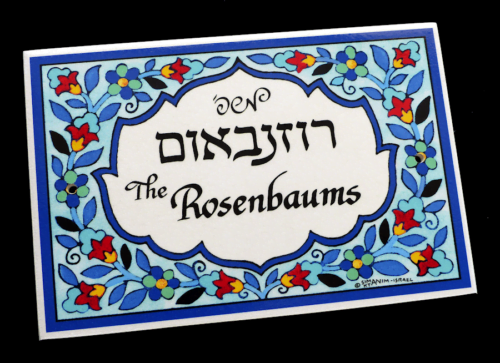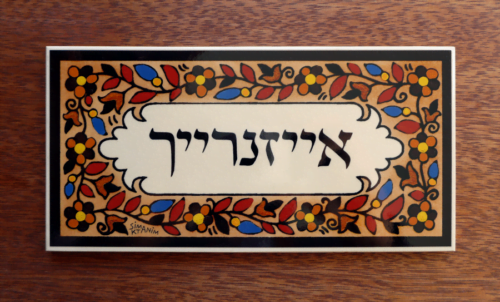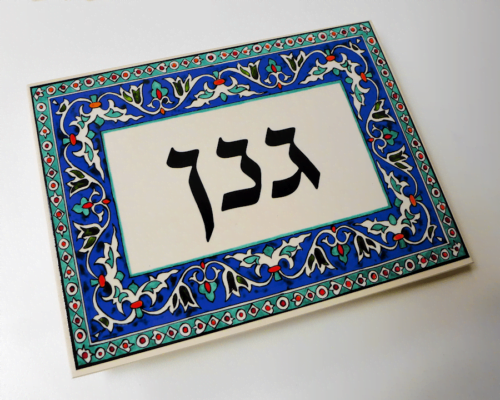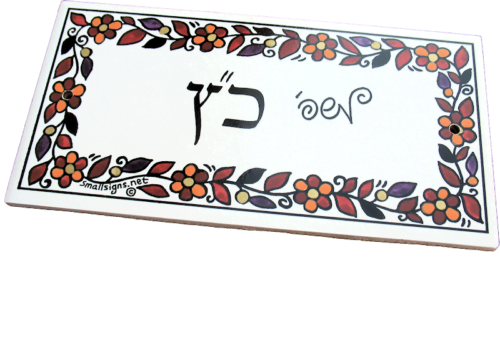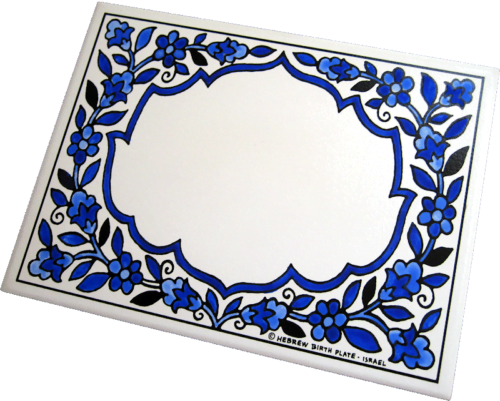Armenian Ceramics
Above a list of models belonging to the Armenian Signs subcategory.
Due to their size (up to 20 cm wide) all Armenian Signs models are suitable for mounting on doors or on the wall near the door.
If you are looking for larger Armenian signs, to assemble outside the house on a wall, fence or gate, visit Ceramic House Signs, especially the Classic Armenian House Sign model.

Brief history of the Armenian ceramics in Jerusalem
The origin of the Jerusalem-Armenian pottery goes back to medieval times. In the post-medieval period the Armenian ceramics industry flourished at one major center: Kutahya, a city in western Asia Minor 125 miles southeast of Constantinople. An Armenian colony is already noted there in the thirteenth century and in the fourteenth and fifteenth centuries there was an active scriptorium too. Armenian manufactured ceramics came to dominate the craft industry of the city. Certainly by the fifteenth century, Armenians were deeply engaged in ceramics. The earliest dated pieces, inscribed on the bottom in Armenian, are from the early sixteenth century. They are decorated in the characteristic blue and white of early Kutahya ware. By the seventeenth century a highly polychrome faience was fabricated with yellow, green and the famous Armenian tomato red. The potters produced vessels in a large variety of shapes for diverse use.
The town became renowned as an Armenian ceramic center in the Ottoman Empire, and was the major competitor of Iznik, the famous source of most “Islamic” tiles and vessels of the Ottomans.
The Kutahya potters also produced square tiles for wall decorations. These were used in a number of mosques, mostly in Constantinople, as well as in churches. The most spectacular display of Kutahya tiles is in Armenian Cathedral of St. James in Jerusalem. Among the thousands decorating various parts of the monastic complex there is a special series of pictorial tiles with polychrome scenes of the Old and New Testament accompanied by an inscriptional band in Armenian. These were specially commissioned in the early eighteenth century for the renovation and decoration of the Church of the Holy Sepulcher, but due to a dispute between the various religion authorities that enjoyed custody over this holy shrine, the work was never carried out. Thus, these Kutahya tiles were used to embellish the Armenian Patriarchate.

One of the most popular forms originating from the kilns at Kutahya was the egg-shaped ornaments hung on the chains from which oil lamps were suspended in churches and mosques. They may have had more than just an ornamental use; some experts considered them as barriers against mice who, attracted by the animal fat used in these lamps, would slide off the slick surface of the egg as they made their way down the chain to the vessel bearing the oil.
Kutahya eggs are variously decorated, but the most common type displays seraphim, the famous six-winged guardian angels. Other popular shapes of these ceramics are the demi-tasse cups without handles, saucers, monogrammed plates, rose-water flasks, and lemon squeezers. Armenian inscriptions abound on Kutahya vessels, whether eggs or water jugs, flasks or incense burners. The Armenian ceramic industry in Kutahya flourished until the Armenians were forced to leave the city during the persecutions of World War I. Several families settled in Jerusalem, where they continue to produce the polychrome Kutahya style ceramics as souvenirs of the Holy Land. New Julfa, the Armenian suburb of Isfahan, founded in the first years of the seventeenth century, also was a center of Armenian tile production. Large pictorial panels made of square tiles painted in yellow and blue are found in situ in various Armenian churches of the city. The scene of the Presentation Magi in the Church of St. Gevorg dated by an Armenian inscription to 1719 is a fine example. Functional pottery continued to be made in Greater Armenian right up into the twentieth century. The ceramic craft is still practiced in Armenia with much skill. During these modern centuries, many shapes known from the excavated pottery of Dvin and Ani continued to be fashioned in villages throughout the land, confirming the consistent tradition ceramic fabrication has always had.
This excerpt is from “The Arts of Armenia” by Dickran Kouymjian. Lisbon: Calouste Gulbenkian Foundation, 1992,. By Courtesy of Dr. Dickran Kouymjian.Door & House Ceramic Signs in custom design
If you have not found your model among the ones listed above and you have a special design idea, please fill out a quick contact form and we will get back to you soon with interesting suggestions – try us!
- Fill the Custom Ceramic Sign Form now
- See pictures of ceramic signs that we made in custom designs:
– Printed Signs (heat printed)
– Painted Signs (ceramic oven)
Free Consulting
Send us pictures of your plaque fitting location – your wall, fence, door or gate – and we’ll suggest relevant options.
Call or Whatsapp Ugo! +972 (0)52-6413373 (Israel)
Order Now and get a Mock Up within hours!
Don’t forget to visit the Image Gallery of each model (Orange button in each model page)!




